A Harvest of Regulatory and Technical Updates
Open Research Institute is a non-profit dedicated to open source digital radio work. We do both technical and regulatory work. Our designs are intended for both space and terrestrial deployment. We’re all volunteer. You can get involved by visiting https://openresearch.institute/getting-started
Membership is free. All work is published to the general public at no cost. Our work can be reviewed and designs downloaded at https://github.com/OpenResearchInstitute
We equally value ethical behavior and over-the-air demonstrations of innovative and relevant open source solutions. We offer remotely accessible lab benches for microwave band radio hardware and software development. We host meetups and events at least once a week. Members come from around the world.
Subscribe to this newsletter at http://eepurl.com/h_hYzL
Ribbit Radio Update
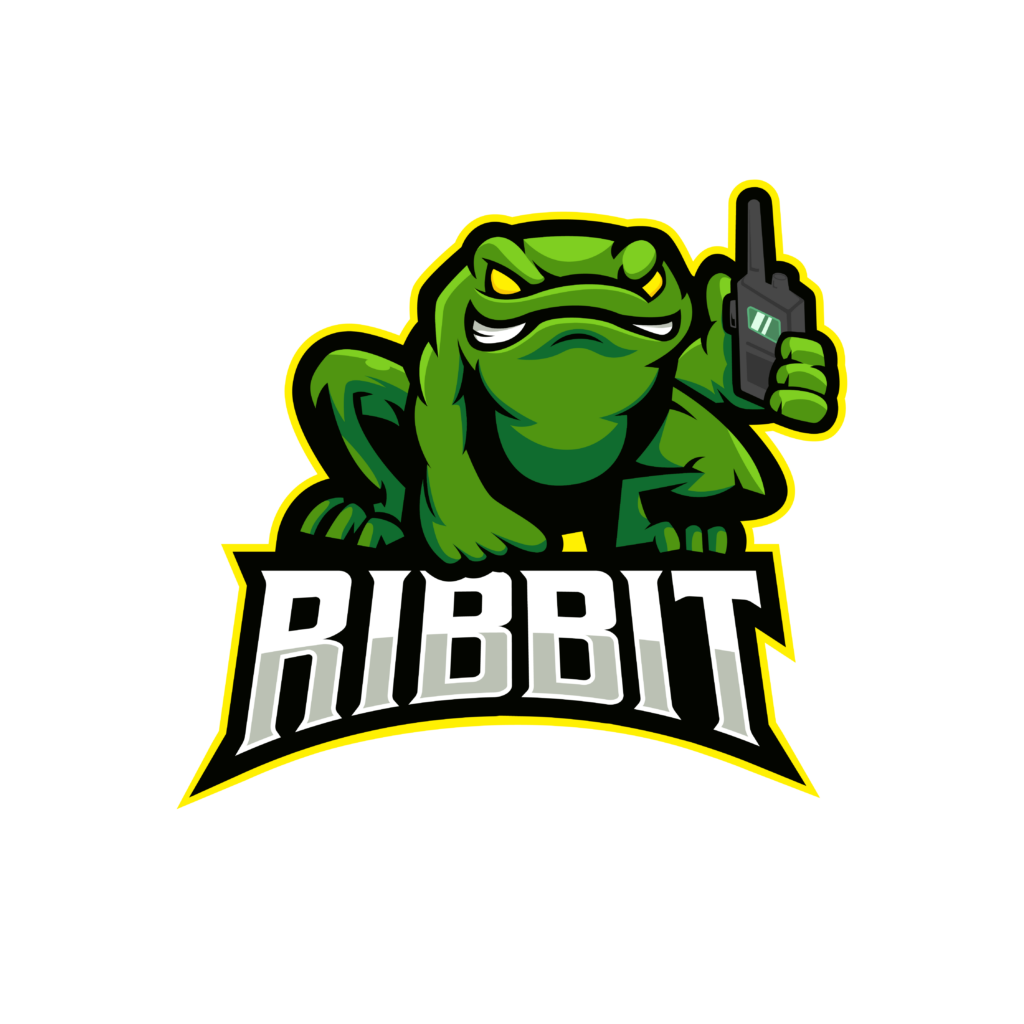
It isn’t often that a completely new way of using existing technology in a truly innovative way on the amateur bands excites the community, but Ribbit consistently delivers.
What is Ribbit?
Ribbit is a novel digital text messaging mode for VHF/UHF communications for recreational and emergency use. It radically increases the density of information transmitted by spectrum used. Ribbit turns text into encoded audio, which can be played from your smartphone into the microphone of any radio, on any band, under even very noisy conditions. A smartphone with the Ribbit application on the other side can recover this message. Your information will get through.
Ribbit leverages the computing power of the modern smartphone to increase the capabilities of any Handy Talkie without requiring any additional hardware or cable.
Its redundant distributed nature allows it to function even when internet connectivity is lost during emergencies or just not available due to poor coverage.
Developer Updates
Project Lead Pierre W4CKX and Rattlegram Developer Ahmet Inan supported a transition of project development to Alex Okita KO6BVA in late 2023. Since then, Alex has made several big strides forward in both development and demonstration.
Alex’s most recent TO DO list included the following tasks.
1) Building a scheme to compact the header for Ribbit. The header is a bit long and could be shortened to save some bits using a raw bit stream of a simplified character map.
2) Add a keyEncoder to Code Witches as the keyboard input gets letters added. When the “Enter” key is pressed begin encoding/consuming the characters in the input area.
3) May also want to add in a sort of message queue above the input area.
4) Build a useful CW-Font for code witches and anything else anyone wants to use it for.
All of this work enabled a highly successful demonstration of Ribbit at DEFCON 32 in Las Vegas, Nevada, in mid-August 2024. A special thank you to RF Village for hosting ORI’s Open Source Showcase.
Visitors to the exhibit were able to see Ribbit work in a busy and noisy environment. DEFCON, like most other very large conferences, is acoustically noisy, but also very electrically noisy. Ribbit was demonstrated all weekend long in a very harsh environment, as the WiFi Capture the Flag competition was happening literally steps away from the Ribbit demonstration. The venue, Las Vegas Convention Center West, was full of conference attendees. Despite the background noise and substantial RF interference, Ribbit worked from Smartphone app speaker output, to Family Radio Service microphone input, over the air on a busy FRS channel, to the receiving FRS radio speaker output, to a Ribbit application microphone input on the monitoring smartphone. Being able to transmit and reliably receive accurate text data is a notable achievement.
Alex has integrated the Ribbit functionality into a web application. This makes Ribbit even easier to use than traditional native applications. The live web app demonstration can be found at https://badkangaroo.github.io/
Recordings of presentations about Ribbit, along with posters and diagrams, can be found at https://www.ribbitradio.org
The source code can be found at https://github.com/OpenResearchInstitute/ribbit_webapp
Practical Real World Use
The technical demonstration for Ribbit, called Rattlegram, got very positive reviews for utility in the field from Chile and Argentina mountain rescue groups. The challenge is supporting hikers and skiiers in places where cellular coverage is limited or not available. Ribbit functionality provided clear benefits with no downsides.
Carlos, our contact in Argentina who supports mountain rescue operations, described his experiences using Ribbit technology.
“Hi everyone, how are you? I’m just back from the mountains in Chile. We did some testing with Rattlegram, in very windy conditions (without any cables) and worked just great !
Send you a picture & video of one of the test we made. We were at this summit:”

In Argentina, Carlos reported:
“These past few months, we have been going out to the mountains, and been using Rattlegram with lot of success. In one of the ‘refugio’ we left an old cell phone with Rattlegram loaded besides the base radio, and we have been sending messages in all the backcountry ski outings and all the messages arrived without a problem.”
If Ribbit can work on the top of the mountains in Chile and Argentina, and if it also performs really well in noisy urban environments, then what can’t it do?
Ribbit Can’t Flourish Without Your Support
Ribbit is innovative, useful, and fully supported by Open Research Institute. But, it won’t realize its full potential without continuing development and community support. If you are excited about Ribbit and want to help, please join ORI at https://openresearch.institute/getting-started and let us know you want to get involved with Ribbit. We’ll make sure you get on the mailing lists and Slack channels.
ORI graciously accept donations for Ribbit development. Ribbit has a dedicated bank account, follows non-profit best practices, has an enforced code of conduct, and regularly reports to ORI leadership.
Thank you to everyone helping make Ribbit successful, useful, exciting, and fun to use!
Opulent Voice Comes to the PLUTO SDR
An Open Source Minimum Shift Keying Implementation

Opulent Voice is the native digital voice and data protocol for ORI’s open source satellite (or terrestrial) system called Haifuraiya. With high fidelity voice quality, seamless integration of data, keyboard chat, and authentication and control messages, amateur operators experience something truly new and enjoyable. As described by ORI Director Steve Conklin AI4QR, “Leave scratchy and harsh proprietary vocoders with clunky or incomplete data mode integration behind for good.” All source code at https://github.com/OpenResearchInstitute/pluto_msk
Things worth doing are rarely easy. The Minimum Shift Keying (MSK) implementation of Opulent Voice (OPV) on the PLUTO SDR is no exception. Challenges to the documentation, design, implementation, and test cycles have come up throughout the process. The response from the open source digital radio community has been solid, inspiring, and productive, with patient problem-solving winning the day every time.
Michelle Thompson, ORI’s CEO, described her perspective on OPV’s progress recently at an IEEE event, stating:
“I would like to thank everyone helping ORI achieve ambitious goals for our uplink protocol. It’s a real pleasure to serve this community and meet the needs of this project. It’s a privilege to be part of something so innovative and relevant.”
This feeling is reflected by the OPV volunteer team, who are actively involved around the world in promoting open source work and helping ORI projects like OPV succeed.
Successes Over the Past Quarter and Current Status
OPV was the communications downlink for a NASA RockSat-X mission executed by the University of Puerto Rico, one of the most consistent and successful teams participating in this competitive program. The mid-August 2024 launch from Wallops went flawlessly. The performance of OPV met all expectations and data recovered from the launch is being used to further develop and improve the communications protocol.
OPV presentations at HamCon:Zion and DEFCON during the summer of 2024 were extremely well received, giving positive educational value to the community. Amateur Radio deserves quality digital communications. OPV delivers excellent results and is well-documented.
There is still a long way to go. The physical layer work is currently focused on tuning the tracking loops in the demodulator. Once the physical layer is reliable, then the functions that integrate voice, data, keyboard, and channel control messages will be integrated into the PLUTO SDR build and tested. Application layer functions in HTML 5 have a head start, with some tests already completed. Parallel integration efforts from F5OEO and OpenCPI, both of which will expand the number of hardware platforms that OPV can use, are well underway.
Below, an example of bit-accurate simulation results for OPV, with signal names on the left and waveform values on the right.

Below, the spectrum of OPV, showing main lobe null-to-null span of 81 kHz, and signal sidelobes.
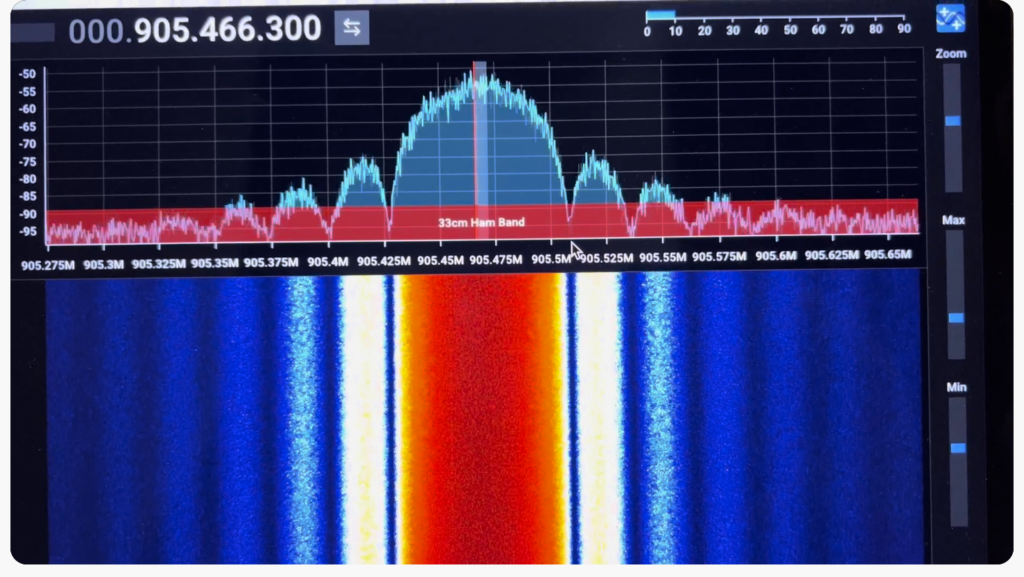
Haifuraiya and Modem Module Update
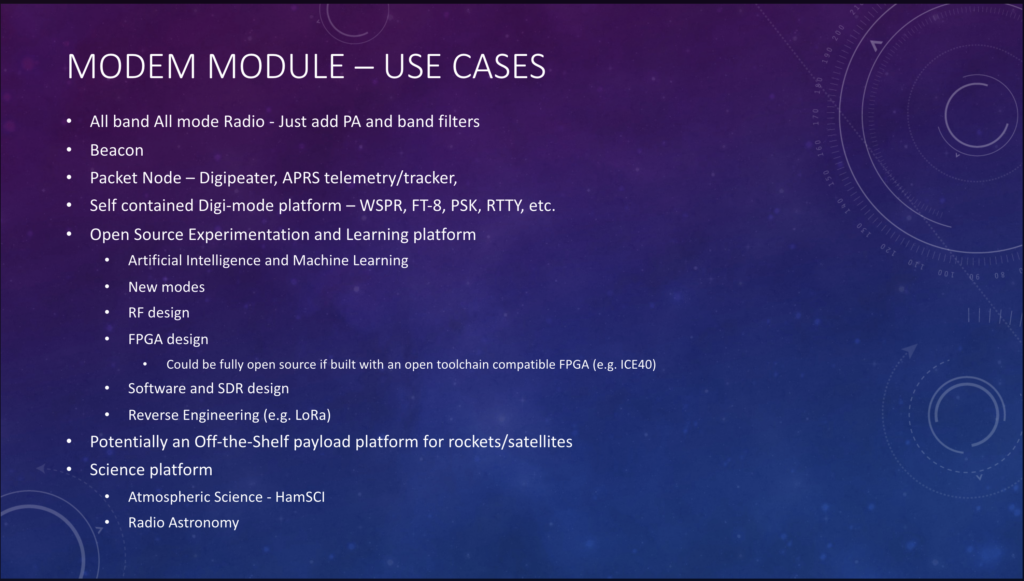
The work on Haifuraiya has broader appeal than just as a HEO/GEO satellite design. The “modem module” approach, developed by Matthew NB0X, is summarized at left.
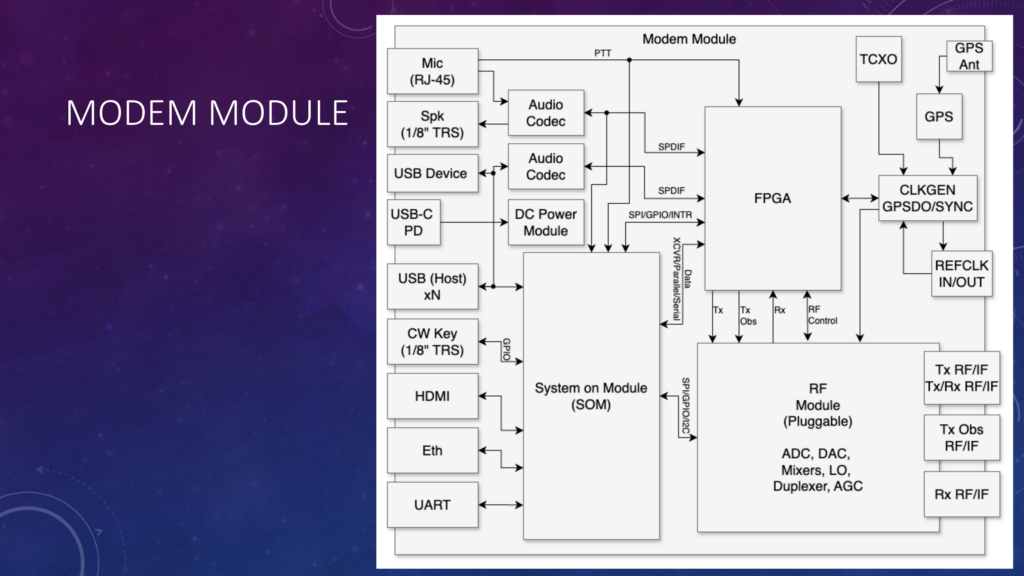
At left is the most recent high level block diagram.
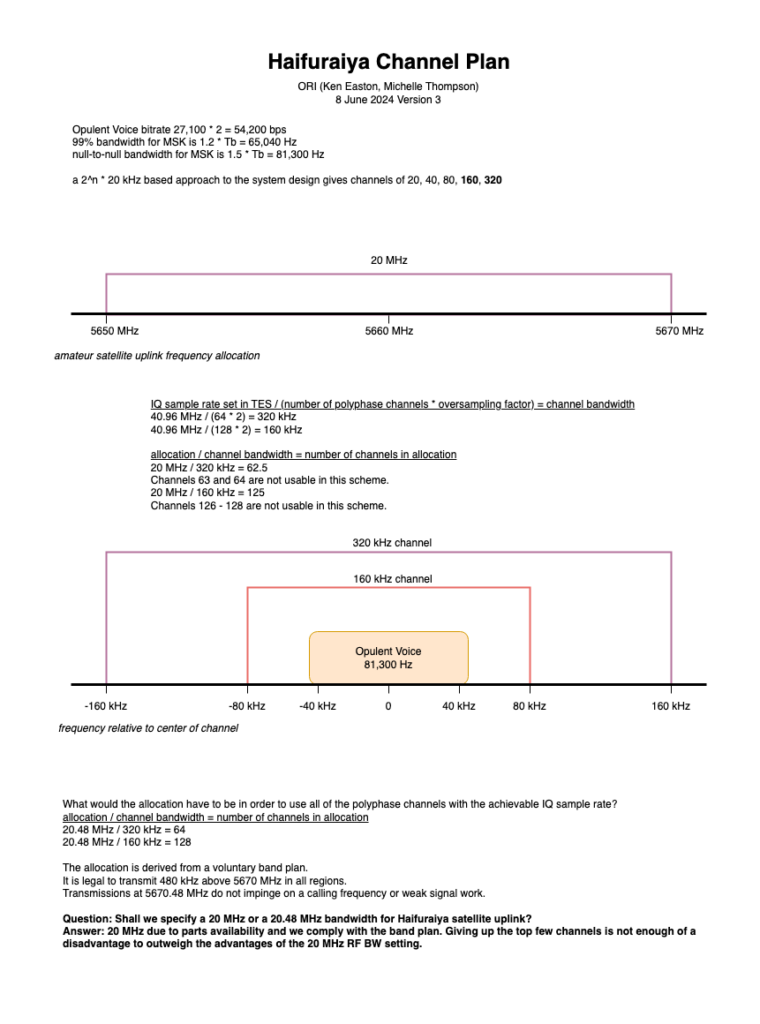
Haifuraiya – Open Source HEO/GEO Amateur Satellite Update
The multirate channelizer has been implemented in Remote Labs West on the zc706/ADRV9009 station. At left is a summary of the channel plan for the satellite receiver.
Regulatory Work at ORI
Making Open Source Easier for Everyone
Past regulatory work at ORI can be found at
https://github.com/OpenResearchInstitute/documents/Regulatory
A special Halloween season workshop about exorcising the Haunted Band of 219-220 MHz was held by IEEE and ORI on 29 October 2024.
The Zoom meetup was well attended with the majority of RSVPs participating on the call. The meeting was recorded for those that couldn’t make it. The video recording of the background session, followed immediately by the workshop, can be found at https://youtu.be/wGX__qcFrT4
219 MHz is a secondary allocation for amateur radio. It has excellent channel characteristics, is open to fixed point-to-point digital links only, allows 100 kHz bandwidths, has a minimum of 56 kbps data rates, and has had no activity for decades. It’s time to take this band back!
Why is there no activity? We believe this band is inactive because of the notification requirements in FCC part 97 and part 80. We assert that these notification requirements, which pull ARRL into the loop from two different directions, are impossible for both amateurs and commercial licensees to comply with.
What are these notification requirements? If you as an amateur want to operate on 219 MHz, you have to determine if there’s an Automated Maritime Telecommunications System (AMTS) station within 80 km of your amateur station. You then have to ask permission from the AMTS station(s) in order to legally operate with at least 30 days notice. If you are between 80 km and 640 km, then you have to notify the AMTS stations at least 30 days in advance of activating the band.
A publicly accessible database of amateur and AMTS stations on 219 MHz is supposed to be maintained by ARRL. This is a rule in Part 97 (for the amateur radio stations) and in Part 80 (for AMTS stations). This database does not appear to exist.
AMTS stations did not report their information to ARRL. Requests to ARRL for a copy of AMTS stations have not been answered. Requests for a copy of amateur radio stations that have notified the ARRL of intent to operate have also not been answered.
These requests were made by multiple amateur radio operators in the October – December 2023 time frame. This was before the cyberattack in 2024, which did sideline a lot of ARRL’s services and activities.
The 219 MHz band regulations need a serious overhaul. We believe a proposal for new rules for this band are a necessary step towards restoring amateur use of this band. We believe that rules can be proposed that will both promote modern and innovative digital activity, and at the same time, not endanger the primary licensees in any way. While the AMTS service no longer exists as originally envisioned, the AMTS licenses have been leased out to fundamentally different services, such as railroads. These primary licensees can share the band with amateur radio in, at the very worst, a mutually inoffensive way and, at the very best, a mutually beneficial manner. It’s up to us to make this better future happen.
In order to make an effective proposal to the US FCC for updated rules for this band, there are things that we need to sort out. We need to know what we want and we need to know what the primary users want. We need to anticipate and answer objections to dropping the onerous notification requirements, and we need to clearly state the value that an amateur radio allocation on this band brings to education, public service, citizenship, and technical advancement of the radio arts.
The workshop on 29 October was the first strong step towards sorting out a draft of proposed rulemaking for restoring amateur radio service use of the 219 MHz band.
Discussion during the workshop resulted in an outline for a draft rulemaking proposal. ORI sincerely thanks everyone that participated during the event and through email correspondence.
Draft Outline
1) Demonstrate that the current rules are not working. State our case that the notification requirements are impossible to comply with and are the reason that there is no activity on this band.
2) Cite 60m as an example of successful similar activity.
3) Assert, providing evidence, that amateur radio operators already know how to share spectrum with other services. We already know how to not cause problems for the services that we share spectrum allocations with. We do not need additional notification requirements or to sign declarations to the ARRL in order to be able to successfully operate on an amateur radio band as a secondary user.
4) Show, from a ULS database perspective, the current utilization of 219-220 MHz. Amateur activity does not threaten primary licensees.
5) Show, to the best of our ability, the actual use of 219 – 220 MHz. This will require a call for participation for sensing stations, such as WebSDRs, amateur operators, receiver enthusiasts, and distributed receiver networks such as SatNOGS, to monitor 219-220 MHz for some period of time, in order to measure primary licensee activity on the band.
5) We assert that AMTS no longer exists. The current primary licensees are not coastal stations. The rules assuming coastal activity do not reflect the reality of this allocation as it exists today. Old rules are hampering efficient use of the spectrum.
6) Propose specific deletions of rules. What exactly should and could be struck down?
7) What are the anticipated effects, repercussions, both positive and negative, of deleting the notification requirements.
8) Is there anything else that could or should be changed? We discussed the 100 kHz bandwidth requirement and it’s origins in specific equipment available to amateurs at the time. Current FCC thinking is to not have rules that hardcode in equipment requirements. Deleting the 100 kHz bandwidth limit in favor of no bandwidth or symbol rate limit had broad support at the workshop.
Thank you to all of you that support our regulatory work. It will take a lot of time and effort to draft proposed rules and to go through the proposal process. The FCC may or may not choose to entertain new rules for 219 MHz. If they do, then a public comment period will happen. If they do not, then the draft rules will still be of benefit, as they will record the point of view and consensus of digital mode amateur radio experimenters and enthusiasts.
Please join this effort at ORI by visiting https://openresearch.institute/getting-started
Sphere of Activity
July 12-13 2024 – ORI exhibited at HamCon:Zion in St. George, Utah, USA. We invited Deep Space Exploration Society (DSES) and QRZ.com columnist Dave Jensen to join our booth. We showcased their work alongside our technical and regulatory acheivements. Total staff was three for this weekend event at a very nice conference center. Some of the travel expenses were reimbursed by ORI. This collaboration was entirely successful. Our CEO gave a talk about AI/ML in Amateur Radio at HamCon’s forum, which can be seen at https://www.youtube.com/watch?v=ZgHUavf5Ddo
August 8-11 2024 – Our Open Source Digital Radio exhibit at DEFCON 32 in Las Vegas, Nevada USA was a big success. ORI hosted demonstrations from RFBitBanger, Ribbit, Opulent Voice, and our Regulatory team in the RF Village. A staff of four set up, staffed, and tore down the exhbit. Travel and lodging was funded by ORI. Our CEO gave an RF Village talk about Synthetic Aperture Radar and Amateur Radio, which can be seen at https://www.youtube.com/watch?v=fiR4woe4O5Q
August 29 2024 – ORI participated in the quarterly Federal Communications Commission Technology Advisory Council meeting and presentation in Washington, DC. ORI is represented on the FCC TAC by Michelle Thomposn and Matthew Wishek. Open Source and Amateur Radio interests have been defended at the federal level. ORI Contributions to the Dynamic Spectrum Sharing and 6G Working Groups can be seen in the video at https://www.fcc.gov/news-events/events/2024/08/technological-advisory-council-meeting-august-29-2024 If you are interested in supporting regulatory participation and defense, please join ORI, support ORI’s work, and let us know how you want to help.
October 2-9 2024 – ORI organized a week-long event called Digital Update for Microwave (DUM) in Vancouver, British Columbia, Canada. There were 3 on site for this event and 9 participants virtually. Housing was reimbursed by ORI. The focus of the workshop was Opulent Voice and Iterative Receiver Theory technical work. We did not address the 10 GHz antenna questions posed from our outreach prior to the event due to time limitations. Better 10 GHz mobile radio gear is what people are looking for, and this will get attention from ORI over the next quarter. DUM is an event that provides opportunities for people interested in digital communications on the amateur microwave frequencies. The contributions to ORI’s GitHub repositories showed that DUM was well worth the effort. Should ORI have a DUMII?
Thank you to all who support our work! We certainly couldn’t do it without you.
Anshul Makkar, Director ORI
Frank Brickle, Director ORI
Keith Wheeler, Secretary ORI
Steve Conklin, CFO ORI
Michelle Thompson, CEO ORI